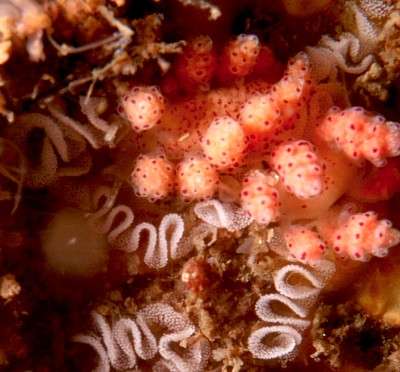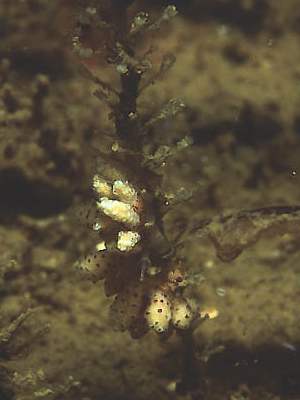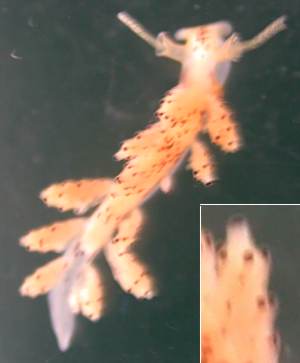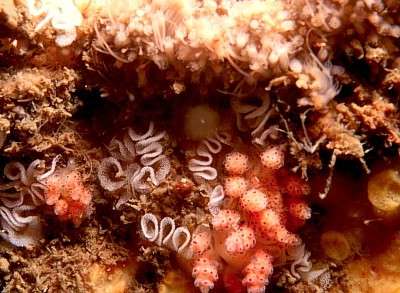
Doto sp. 8
Order: NUDIBRANCHIA
Suborder: DENDRONOTINA
Family: Dotidae
DISTRIBUTION
Atlantic Coast of Nth America
PHOTO
New York. Photo: Betsey Hansen
Yellowish with black-tipped ceratal tubercles. Previously tentatively identified with the European species, Doto coronata but see discussion in messages below suggesting that this is unlikely.
Authorship detailsRudman, W.B., 2003 (March 18) Doto sp. 8 [In] Sea Slug Forum. Australian Museum, Sydney. Available from http://www.seaslugforum.net/find/dotosp8
Related messages
Doto coronata? from Eastport, Maine, USA
September 8, 2003
From: Alan Shepard

Bill,
Here is a shot of a pair of what we call Doto coronata from Eastport, Maine. The photo is not the best as the nudibranchs were nestled at the base of a hydroid.
They were each about 8 to 10mm long and were found at about 10m on a hydroid covered pier piling that had collapsed in the water. There were many D. coronata on the piling.
As I mentioned in an earlier message this is the typical looking D. coronata in New England.
Sincerely,
Alan Shepard
Tolland, CT, USA
alan.chepard@snet.net
Shepard, A., 2003 (Sep 8) Doto coronata? from Eastport, Maine, USA. [Message in] Sea Slug Forum. Australian Museum, Sydney. Available from http://www.seaslugforum.net/find/10896Thanks Alan,
You will see I have put the specimens from the east coast of Nth America, which look like Doto coronata on a separate page as Doto sp. 8 in deference to Bernard Picton's belief that that species is a complex of very similar looking species which still need to be investigated.
Cheers
Bill Rudman
Re: Doto from Massachusetts, USA
March 20, 2003
From: Peter H. van Bragt
Katy and Bill,
Identifying Doto's just from a picture is indeed a very difficult matter. For Doto coronata we find that a red pigmented area on the inner face at the base of all the cerata is a good feature to identify this species. It is alas not clearly visible on my previous pictures but it does not seem to be present on Katy's Doto. Maybe it is better to call these specimen for the time being Doto sp.? I will see if I can find a slide in my collection that does show this characteristic pigmenation better. I do understand that pigmentation is probably the worst feature to use in the determination of Nudi's like Doto but with only pictures available this is all we can do. It would be nice if Katy could have a look at the radula.
Best regards
Peter
vanbragt.phjm@hsbrabant.nl
Thanks Peter,
I agree we have a problem here. I don't know whether to put all the Nth American east coast Dotos into a single page or attempt to separate them into species. Either way has its problems. At this stage I am separating off Katy's Doto and Betsey Hansen's photos as Doto sp. 8. Superficially, at least, they look to be the same species.
Best wishes,
Bill Rudman
Doto from Massachusetts, USA
March 19, 2003
From: Katy

Hi
I found this guy in a general net sweep off the pier in Provincetown, Massachusetts [Atlantic coast, USA]. It was June or July 2002 in a fairly polluted harbor with the floating docks in tidal waters of 8 feet to about 20 feet. This pier has had ongoing contruction for 2 seasons now with a sand bottom. Often in the hotter days the harbor gets very low oxygen levels causing 'fish kills' of any species kept overboard in traps. I found him on some sea lettuce (Ulva sp.) that I pulled off the dock but this area is heavily overgrown with tunicates and some hydroids. If you can give me an idea of species that would be great.
Thanks so much,
Katy.
katykughen@aol.com
Dear Katy,
This is a species of Doto, which are small dendronotoidean nudibranchs which look very like aeolids. There are two good ways to distinguish them externally. Firstly an aeolid's cerata is usually smooth, without the tubercles seen in your animal. Secondly the rhinophores on Doto are enclosed in a tall collared sheath which is absent in aeolids.
This looks very like the animal from New York that I tentatively identified as Doto coronata in Betsey Hansen's earlier message. However as you will see in that message, there are considerable problems with identifying species of Doto at the moment. They all feed on hydroids, and it seems they probaby all are specilalist feeders on one or a few species of hydroid. So identifying them may eventually depend on identifying their food hydroid.
Best wishes,
Bill Rudman
Doto coronata? from off New York
September 1, 1999
From: Betsey Hansen


Bill,
Michael Miller identified this one for me as Doto coronata. This is another one from the Atlantic Ocean off New York. These were very small, less than 1/2 inch. Once I found the first one, I found several groups all around yellowish orange coral patches anywhere from 12 feet (4 meters) deep to 40
feet (13 meters) deep. I only spotted the eggs at first and didn't realize the tiny orange dots next to the eggs were sea slugs until I got my slides back. A welcome surprise. This picture was taken with a Nikonos V with a 2 to 1 macro framer. I found one yellow one; all the rest were orange.
Best Wishes,
Betsey Hansen
BHScuba@aol.com
Hansen, E., 1999 (Sep 1) Doto coronata? from off New York. [Message in] Sea Slug Forum. Australian Museum, Sydney. Available from http://www.seaslugforum.net/find/1273Dear Betsey,
This is another interesting find. There are a few records of Doto coronata from North America (Loveland et al, 1969) but most European workers suggest it has a much more restricted distribution in northern Europe. Of particular interest is a publication (Morrow et al, 1992) which showed that 'Doto coronata' is probably a complex of similar looking species. They used electrophoretic techniques to show that at least 3 species could be distinguished in the northern Irish Sea, each feeding on a different species of hydroid, Doto coronata on Eudendrium, and 2 new species, Doto sarsiae on Sarsia eximia and Doto hydrallmaniae on Hydrallmania falcata. Henning Lemche also considered that Doto coronata was a complex of species each species feeding on a different hydroid. See Bernard Picton's website for photos of the three species.
Possibly your species is not Doto coronata but something new.
Best wishes,
Bill Rudman.
References:
* Morrow, C.C., Thorpe, J.P. & Picton, B.E., (1992) Genetic divergence and cryptic speciation in two morphs of the common subtidal nudibranch Doto coronata (Opisthobranchia: Dendronotacea: Dotoidae) from the northern Irish Sea. Marine ecology progress Series, 84: 53-61.
* Just, H. & Edmunds, M. (1985) North Atlantic Nudibranchs seen by Henning Lemche. Ophelia Publications, Supplement 2: Helsingor.
